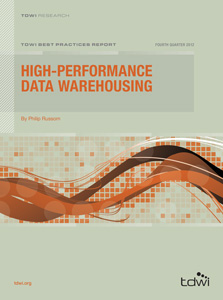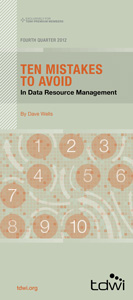 View online: tdwi.org/flashpoint
View online: tdwi.org/flashpoint





February 7, 2013
ANNOUNCEMENTS
Call for entries:
TDWI Best Practices Awards 2013
Submissions for the next Business Intelligence Journal are due February 22.
View submission guidelines
CONTENTS

Inside the Analytic Mindset:
Creating the Data You Need

Replacing Platforms to Enhance Performance

Mistake: Lack of Data Management Accountability

See what's
current in TDWI Education, Events, Webinars,
and Marketplace

Inside the Analytic Mindset:
Creating the Data You Need
John O’Brien
Radiant Advisors
Topics:
Data Analysis and Design, Data Management, Data Warehousing
There are many differences between a business intelligence (BI) mindset and a business analytics (BA) mindset. Business analytics focuses on designing an algorithm that achieves a specific business objective by leveraging data as variables. Analytics developers typically work separately from BI and data warehousing teams and seek out data that builds an analytic model to achieve business objectives. Although a business intelligence mindset is frequently concerned about where the data comes from, a BA professional analyzes and leverages data from the data warehouse, operational systems, external data, and user-generated data, and in some cases considers how to create the data needed.
A new role should be created in BI/BA teams for creating applications that generate the required data. For example, many years ago while performing operational analysis for a major bank, we needed to capture deposit and check volumes arriving at our centralized facility so our 100-plus staff could micro-encode, balance, and batch them for the clearinghouses. Each staff member had different throughput rates and quality levels. In order to capture the data needed, a very simple--albeit crude--method was used: a yardstick taped to a countertop. We measured the stack of checks in inches, translated one-inch thickness as 100 items, and recorded the arrival time stamp and branch number.
With that daily data (and years of history), we accurately forecasted workloads and optimized staff levels, rewrote courier pickup routes to save 40 percent in expenses, and analyzed business changes such as new banking hours. The BA mindset here: sometimes having data is more important than its accuracy. Think outside the box and own the responsibility for creating the data you need.
Throughout the years, this BA mindset has served well to solve the lack of sales channel data at major wireless carriers for telecom metrics, and, more recently, at one of the largest Internet carriers for monitoring its network. There, our BI team wrote our own applications to be installed on thousands of servers and network switches. The applications monitored network traffic every second, captured those metrics, and then aggregated them into five data packages to be shipped to a central collection manager program. Now we could monitor the massive network in real time. In this case, the BA mindset was to write a small agent program to distribute across the infrastructure and machine-generate the data we needed to solve the business challenge of operating a network.
If you look around carefully, you’ll discover how major technology companies are creatively building new ways to capture the data they need for business analytics as well as to become a business that runs on information. Google has long been recognized for analyzing the Web and constantly improving with user behavior data. I recently noticed the Google Chrome browser now leaves a blue strip on the website I’m reading as I scroll--Google is at it again, capturing how I read websites. Recently, it was reported that Amazon captures all the data from its Kindle e-readers and downloaded books, such as book titles, reading speed and frequency, highlights, book abandonments rates, and more--all great data for e-book analytics and the publishing industry.
In recent discussions with BI vendors, I asked why they don’t offer the data that captures how reports and BI applications are being consumed. With this information, BI teams could optimize their programs by analyzing which BI apps are used most often, which screens and widgets are most popular, which metrics are drilled through most often and through which path, and so on. Leveraging database tools to capture SQL queries is not enough; asking users to add comments (or ratings) is asking too much. The BA mindset is to take the initiative to instrument and capture BI user behavior without imposing on users.
The next time you’re faced with a BI or BA project, don’t limit yourself to the “what data do we have in the operational systems” mentality. Think about your business objective and what data you need in order to deliver analytics and useful information to business users. Then think about how you can creatively generate that data yourself, rather than relying on other applications or development teams.
John O'Brien is a recognized thought-leader in BI more than 25 years of experience. As principal and CEO of Radiant Advisors, John provides research, strategic advisory services, and mentorship to guide companies in meeting the demands of next-generation information management, architecture, and emerging technologies.

BI Dashboards the Agile Way
Paul DeSarra
Although the concept of agile software development has been around for more than 10 years, organizations only recently began to think about how this methodology can be applied to business intelligence (BI) and analytics. BI teams are continually evolving their rapid delivery of additional value through reporting, analytics, and dashboard solutions. These teams must also discover what types of BI solutions can reinvigorate a BI deployment and produce meaningful results.
One way to reinvigorate BI deployments is to take the concept of agile software development and apply it to BI initiatives such as BI dashboard solutions, which can both re-engage the business and drive actionable intelligence and confident decision making. Agile BI replaces traditional BI project methods (heavy in documentation and process) with a user-driven approach. This article discusses an approach to building BI solutions and dashboards using an agile software development methodology.
Read the full article and more: Download Business Intelligence Journal, Vol. 17, No. 4


Highlight of key findings from TDWI's wide variety of research
Replacing Platforms to Enhance Performance
A data warehouse platform can be defined in different ways. For some users, it’s mostly the DBMS where data is managed and operated on. But a platform also includes server hardware, an operating system, storage systems, and network. Regardless of the definition, many users are contemplating a replacement of their current primary data warehouse platform. (See Figure 7.)
Roughly half of user organizations will keep their DW platform. They have no plans to replace the current analytics platform (49%). No doubt, a few would like a replacement, but don’t have the budget or approval to do so. But TDWI suspects that most get what they need from the current platform, so they are not compelled to swap it for another.
One-tenth (12%) have already replaced their DW platform. There are many viable reasons for a replacement, as we’ll see in the discussion of Figure 8.
One-third anticipate replacing their DW platform within three years. Thirty-four percent say the replacement will occur in 2013, 2014, or 2015. Another 5% anticipate a replacement soon after that.
Read the full report: Download High-Performance Data Warehousing


FlashPoint Rx prescribes a "Mistake to Avoid" for business intelligence and data warehousing professionals.
Mistake: Lack of Data Management Accountability
Dave Wells
Many people in various roles interact to manage data quality, security, and utility. People and roles are important concepts of data management. Every role has designated responsibility, authority, and accountability. Individual responsibility, authority, and accountability are the cornerstones of managing data as an asset.
Responsibility is the obligation of an individual in a specific role to perform the duties of that role. The individual is obligated to take actions and produce results that affect data assets. Authority is the power granted to an individual to make decisions and direct others to follow those decisions. Accountability is the individual liability assumed by exercising authority. It is a condition of being fully answerable for results and outcomes.
Responsibility, authority, and accountability are designated to individuals, but data management is performed by organizations. A data management organization works well when these three factors are well aligned. The authority granted is role based and must be aligned with the responsibilities of that role. The accountability of the role must correspond with the scope and level of authority. Gaps and inconsistencies between the three elements are certain to cause dysfunction in the organization. Accountability is the logical consequence of responsibility and authority.
Delegation is an additional consideration to keep in mind when defining data management roles. A particular role may be assigned a specific responsibility with or without the right to delegate that responsibility. When responsibility is delegated, the corresponding authority must also be delegated. Responsibility and authority may be delegated. Accountability cannot be delegated; it remains with the delegator.
Read the full issue: Download Ten Mistakes to Avoid In Data Resource Management (Q4 2012)







